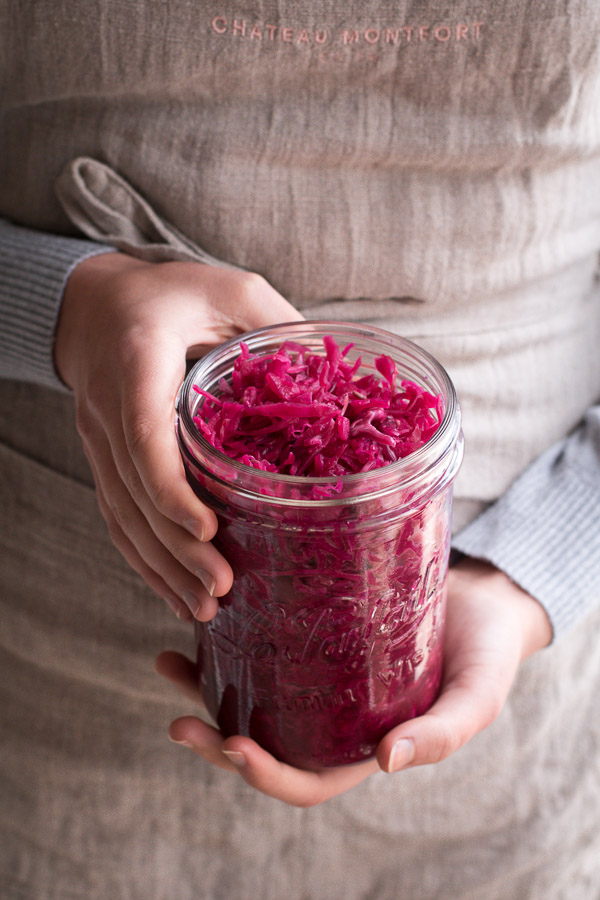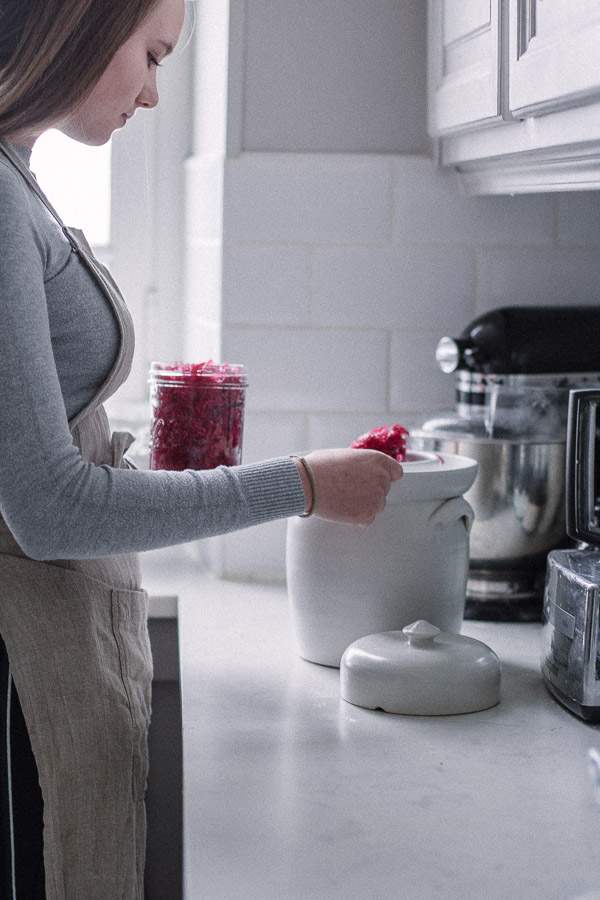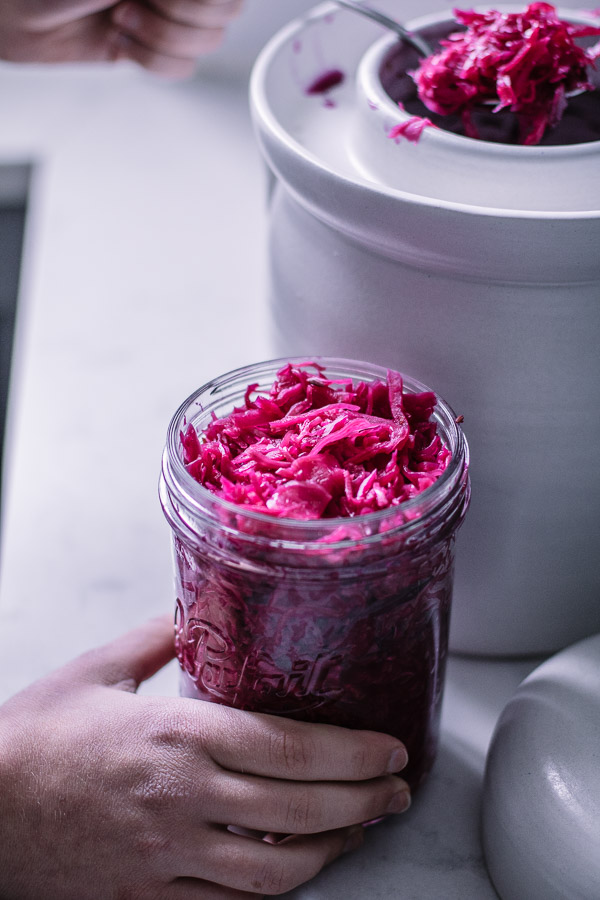
I’m a little obsessed with pickles. In fact, it all started when I was living in Moscow. My weekly visits to the produce market there were a bit like visiting a science lab where almost every fruit and vegetable from the Russian countryside seemed to be preserved for all eternity in brine filed wooden barrels, similarly shaped, to the portly Russian Babushkas who proudly offered taste tests to passers-by. I loved the fennel tips and the pickled heads of garlic, which remarkably, weren’t as garlicky as you’d expect and were great as a snack with a cold beer in the summer. There were even whole pickled apples, which again, were strangely delicious and perfect with roasted knuckles of pork or bbq skewers of shashlik beef.
This is my first batch of sauerkraut using my new pickling crock from Ren Bours Ceramics, (they deliver to almost any country in the world). The crock comes with ceramic weights which help to hold the cabbage down in the pickling juices and the lid is specially designed with a water seal to avoid any unwanted oxygen entering the crock during the fermentation process. They come in a range of colours and I have to say, I absolutely love it! Not only is it great for making sauerkrout, you can also use them to pickle almost anything your heart desires. Come summer, I’ll be pickling gherkins, garlic (Russian style) and Kimchi.
Sauerkraut is a live-culture probiotic food, full of lactobacilli bacteria that improves the functioning of the digestive tract. Live-culture foods can also help restore beneficial bacteria in the gut and are a great source of fibre and essential nutrients, including iron, vitamin K, vitamin C and vitamin B12. Once made, you can store jars of sauerkraut in the fridge for several months.

For a good fermentation you need the following:
- A relatively high salt content (3% on a weight basis),
- The right temperature—not too high ( 18 degrees),
- Pressure on the vegetables in the crock. Ideally, ceramic weight stones are best, but you can also use a small saucer and a few tins or heavy jars on top of it to weigh down the contents.
- A good seal, which provides an acid-free environment. It’s important that there is no oxygen in the crock.
If you’re keen on getting your own batch of sauerkraut going, it’s super easy.
I’d highly recommend reading/listening to the following first:
- Wild Fermentation. The Flavor, Nutrition, and Craft of Live-Culture Foods by Sandor Katz
- BBC Radio 4 The Food Program’s podcast on the art of Fermentation with Sandor Katz and Dan Saladino
- Sandor Katz’s blog Wild Fermentation
- This great video on the art of fermentation
What you need to get started. This will make 3 Kg of sauerkraut:
- 5 medium/large organic cabbages, about 6 Kg.
- 5 large onions.
- Approximately 90 grams of salt.
- A large container for the sliced cabbage.
- A sauerkraut pot. Mine has a volume of 4 liters, which once 3/4 filled, makes 3 Kg of sauerkraut.
- Weight stones, (these come with Ren Bours Ceramics sauerkraut pots).
- A mandoline to slice the cabbage into very thin pieces.
- A cabbage pestle to push the cabbage into the crock tightly. Not essential but very handy.

Sauerkraut flavourings:
- Besides purple and or white cabbage, you can also use other vegetables such as fennel, carrots, radish, celeriac and beetroot.
- Add some flavour: Juniper berries, ginger, lemon peel, caraway or fennel seeds, grated apple, chilli and garlic are all great additions.
How do you use Sauerkraut?
Clearly, a visit to Oktoberfest will help get you going, but failing that try it with the following:
- Sauerkraut is vital to the New York deli’s famous Reuben sandwich; piled high on corned beef with Swiss cheese on rye bread with chilli-spiked Russian dressing. Other good sandwich combos are pastrami or salami.
- It’s great with sausages or salted meats.
- It’s especially good served with smoked fish like hot-smoked salmon or mackerel.
- For a contrast of colour and texture, add cranberries and serve with roasted game birds.
- Add apple. It works really well with pork or chicken.
How to make Sauerkraut:
- Remove the outer leaves from the cabbage and divide it into 4 pieces and remove the core. Important! Don’t wash the cabbage with water.
- Finely shred the cabbage into a large bowl. Very fine slices are essential as bigger pieces will take much longer to ferment.
- Sprinkle most of the salt over the sliced cabbage and massage it into the slices. This will break down the cells and help to release the water from the cabbage. Leave for 2 hours. b. After 2 hours.
- Squeeze handfuls of the cabbage in your hands, releasing as much water as possible. Put a layer of squeezed cabbage in the bottom of the sauerkraut pot (about 5 cm in height) and push it in well. Sprinkle some salt over the layer.
- Repeat until you reach the very top of your sauerkraut pot so nothing can be added to it. Leave the pot, without the lid, for 1 week at a warm temperature.
- After 1 week the top of the cabbage may be infected with mould, don’t panic, this is not harmful, simply remove the top layer and push the cabbage firmly down into the crock to release more of its liquid. Afterwards, place the weigh stones on top of the cabbage. The weigh stones must be under water. Put the cover on the crock and pour water into the airlock on the lip of the crock (see website if you are using the one I use).
- Move the crock to a cool place in the house, a basement or cellar is ideal. The temperature must be a steady 15-20 °C. Never put the crock on a concrete floor; always place some wood or cardboard underneath it.
- After 5 weeks the sauerkraut should be ready. Use only clean (beechwood if available) tongs to remove the sauerkraut and put it and its juice into glass jars.

+ ADD A COMMENT